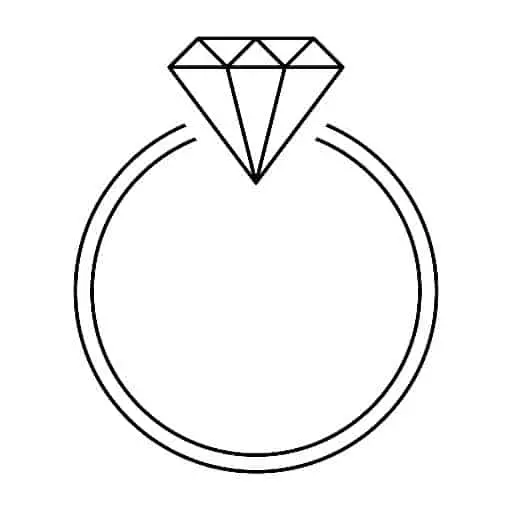Wasting time and money buying Morganite that turns out to be fake, is frustrating! You feel violated. The fake gem is likely made of glass, so you can’t us it in your engagement ring. This information should help you to shop for your gem more confidently, and avoid getting ripped off.
How can you tell if Morganite is real? There are warning signs that a particular Morganite stone might be fake, but the only way to know for sure, is to have it tested by a laboratory. Certification from respected labs can also help. If a price seems too good to be true, it typically is. Many ultra inexpensive sellers send colored glass.
The more you know about Morganite, the easier it will be to spot a fake Morganite stone. Unfortunately, there are a lot of fakes out there, so you’ll need this information!
What is Morganite?
Morganite is part of the Beryl family, like Emeralds and Aquamarine. It’s a beautiful gem that has coloring that’s often a fusion between peach and pink. The shade looks fantastic with most skin tones, and is especially striking when set in Rose Gold.
Brides that want color and uniqueness for their ring tend to love Morganite. While it’s not the lowest maintenance gem available, it’s rich with natural charm, elegance, and beauty. It also helps that it isn’t terribly expensive, in fact, it’s significantly cheaper than a pink diamond.
Morganite was discovered along the coast of Madagascar in the early 1900’s. It was proposed by a gemologist that had the wealthy banking tycoon JP Morgan as a friend and client, that the stone be renamed after him, which is why it’s called Morganite today.
Prior to the renaming, the gem was known as Pink Beryl or Rose Beryl. Impurities in the stone can often give Morganite a more yellow or orange appearance, so stones are often heated as a means of burning the impurities out of the stone, which increases the beautiful pink coloring that Morganite is famous for.
Morganite is a semi-precious gem. All Morganite is currently mined from the earth, not manufactured in a laboratory. It’s primarily mined in Madagascar and Brazil, but is also harvested from China, Africa, Russia, and a couple of places in the US. It’s actually considered to be a fairly rare gem.
In order for a gem to stand up to the wear and tear that it receives in jewelry, it needs to be at least a 7 on Mohs Scale of Hardness. Mohs Scale, is a 10 point scale that shows the relative hardness of various minerals. The way the scale is structured, the higher the number, the harder the material. Morganite is rated at 7.5 to 8, depending on the specific stone being evaluated. That’s harder than some gems used in engagement rings, and much softer than others.
How Do you Perform a Sniff Test?
A “sniff test,” is a quick evaluation of the simple facts of a transaction to see if something smells “fishy” or strange. It boils down to using your intuition or following your gut. It’s based on the premise, that if something seems too good to be true, then it probably is.
This absolutely true of gems! Being the frugal ring buyer that you are, you might scour the internet looking for the lowest possible price on a nice looking 1 carat, round cut, Morganite stone for your ring.
Your searching takes you to eBay, where you’re able to buy the gem for just $79, instead of the $300 price tag that most other jewelers have for a similar item. It’s probably not much of a stretch to say that 99.9% of all cheap Morganite sold on such sites is colored glass.
Aside from the frustration of wasting time on the item, you also wasted money. If a tight budget was the driver that caused you to go with Morganite instead of a pink diamond or some other gem, then you may have lost $79 that you really couldn’t afford to be without.
You obviously can’t use a stone made out of glass. While it might look just like Morganite for a few days, it isn’t, so it won’t have the same optical qualities or durability.
Based on all of that, it’s a good idea to ask yourself if the piece of Morganite that you’re evaluating is just too cheap to be believable. Is it being sold by a company that has a strong history and reputation? While you can’t let your guard down because of the history and reputation of a company, you’re certainly a lot safer overall buying from those types of sellers.
Not all small sellers are intentionally trying to take advantage of you when they sell you fake Morganite. At least in many cases, they’ve purchased from an international supplier, often from China or India, that has sold loose stones or finished rings that were labeled as Morganite. They bought them believing that they are, and are reselling them with full belief that they contain genuine Morganite.
How Can You Get a Professional Opinion?
If you take a piece of Morganite to a local jeweler, they should be able to quickly tell you if it’s an actual stone, or a piece of glass. They won’t need any fancy electronic equipment to test the stone, a simple Loupe is enough. The Loupe, is the eye piece that jewelers use for magnification. Chances are, that they won’t even charge you just to take a quick look to tell you if it’s glass or stone.
You could even talk to hobbyists that you find in local meetup groups if you’d like. Some of them know a lot and could almost certainly magnify your sample to at least tell you whether it’s an actual stone.
Sending the material that you believe to be Morganite to a laboratory for testing, would probably give you the greatest degree of certainty, but it also costs something for the testing. While rates vary, the test and report is likely to cost approximately $70.
What should Quality Morganite Cost?
A quality piece of Morganite that has nice coloring will typically cost about $300 per carat. Of course some will be a little higher and some will be a little lower, depending on where you buy it and number of other factors.
If you find Morganite that’s substantially more expensive than that, you may want to evaluate whether it’s the right place to purchase your gem. If you find prices substantially lower, you may want to proceed with extreme caution, in case the Morganite they’re selling isn’t real.
If you find a nice looking 1 carat Morganite gem that’s $259, should that raise a red flag. No, not in and of itself. I would strongly consider my confidence in the organization selling the stone though. In contrast, if you found a nice looking 1 carat Morganite ‘gem’ that was $30…run!
How to Can I Protect Myself from Being Scammed?
I mentioned reputation earlier, but that’s a really important component. If the local jeweler or online retailer has been open a long time and has a good reputation, that will help decrease the likelihood of an issue. Read product reviews, if they’re available for the stone or ring that you’re considering if they’re available. Pay special attention to the negative ones.
While product reviews are helpful, don’t take a lack of negative reviews as proof that a particular piece of Morganite is legitimate. Glass pieces could potentially end up fooling a lot of people for a long time.
In addition to specific product reviews, it’s a good idea to also search google and Facebook for reviews left by customers regarding the organization. It’s helpful to read positive reviews, but it’s even more important to read all of the negative reviews. Check the Better Business Bureau (BBB) website for complaints that have been filed against the organization that you’re thinking of buying from as well.
After reading through product reviews and any reviews or complaints regarding the organization, you should have a better feel for the quality of the product and the retailer.
A return policy is a really important protection that you should inquire about. If you had a 30-day return policy on a Morganite ring that you purchased, for example, that would provide a little time to stop by another jeweler to get confirmation that your ring isn’t Morganite colored glass.
Store policies that prohibit returns aren’t unusual or suspicious, but they do limit your flexibility and prohibit you from getting confirmation before you make a commitment to a ring you may not yet know enough about.
A Certification on the stone from a reputable laboratory would add a lot of assurance. Certificates from laboratories that aren’t well known shouldn’t be fully trusted. They could be made up for all you know, or they might essentially certify anything they get paid to provide a certificate for.
One of the biggest challenges with unknown laboratories, is that their grading language can be confusing (sometimes intentionally confusing). They can use terminology for their grades that make a stone appear to be of higher quality than it actually is.
I mentioned problems with both intentional and unintentional misrepresentation of jewelry and stones purchased through sites like eBay earlier. Many other sites that offer a platform to connect buyers and sellers have the same issues. They’re dangerous places to do business because it’s so hard to really know who you’re dealing with and what kind of product they’re offering.
Even when past buyers have glowing things to say about the product, there’s know way of knowing if the reviews are real, if they got the same product you’re buying, if the seller or the seller’s supplier made a change that is going to leave you with something very different than you thought you were buying.
My best advice, is to be frugal, but not foolish when it comes to buying your engagement or wedding ring. Too cheap can sometime be as big a problem as too expensive, because it makes you vulnerable to cheats and scammers.
Related Questions:
Is Morganite a Gem That You Can Wear Everyday?
Morganite can be worn everyday if you’re careful with it and your diligent about cleaning it. Some brides enjoy having multiple rings and changing them based on their mood and outfits. Rotating your rings means they see less wear and tear, but also require less frequent cleaning.
Will Morganite Pass for Pink Diamond?
Yes, many people might mistake a Morganite gem for a pink diamond. Jewelers and gemologists could tell them apart, but Morganite is beautiful, and massively cheaper than the diamond.
Which Other Gems are Colorful and Durable?
Stones like Ruby, Emerald, Sapphire, and Topaz come in a variety of gorgeous colors and are worth looking into for a distinctive engagement ring or wedding ring. You may even want to look into colored Moissanite. All of those potential candidates are, at least, as hard as Morganite. Hardness equals scratch resistance, which helps your ring looker longer.

